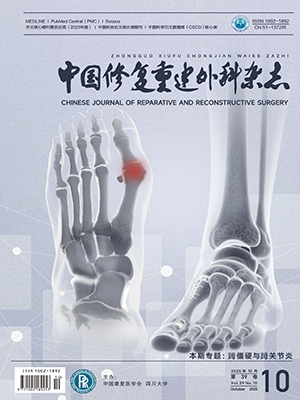| 1. |
Buck DW, Dumanian GA. Bone biology and physiology: Part Ⅰ. The fundamentals. Plast Reconstr Surg, 2012, 129(6): 1314-1320.
|
| 2. |
Zhang J, Tong D, Song H, et al. Osteoimmunity-regulating biomimetically hierarchical scaffold for augmented bone regeneration. Adv Mater, 2022, 34(36): e2202044. doi: 10.1002/adma.202202044.
|
| 3. |
Zhu Y, Jiang S, Xu D, et al. Resveratrol-loaded co-axial electrospun poly(ε-caprolactone)/chitosan/polyvinyl alcohol membranes for promotion of cells osteogenesis and bone regeneration. Int J Biol Macromol, 2023, 249: 126085. doi: 10.1016/j.ijbiomac.2023.126085.
|
| 4. |
Zhang X, Jiang W, Xie C, et al. Msx1+ stem cells recruited by bioactive tissue engineering graft for bone regeneration. Nat Commun, 2022, 13(1): 5211. doi: 10.1038/s41467-022-32868-y.
|
| 5. |
Cui ZK, Kim S, Baljon JJ, et al. Microporous methacrylated glycol chitosan-montmorillonite nanocomposite hydrogel for bone tissue engineering. Nat Commun, 2019, 10(1): 3523. doi: 10.1038/s41467-019-11511-3.
|
| 6. |
Fernandez-Yague MA, Abbah SA, McNamara L, et al. Biomimetic approaches in bone tissue engineering: Integrating biological and physicomechanical strategies. Adv Drug Deliv Rev, 2015, 84: 1-29.
|
| 7. |
Elrayah A, Zhi W, Feng S, et al. Preparation of micro/nano-structure copper-substituted hydroxyapatite scaffolds with improved angiogenesis capacity for bone regeneration. Materials (Basel), 2018, 11(9): 1516. doi: 10.3390/ma11091516.
|
| 8. |
Kharisov BI. A review for synthesis of nanoflowers. Recent Pat Nanotechnol, 2008, 2(3): 190-200.
|
| 9. |
Wang X, Wu L, Wang J, et al. Oxygen vacancies and interfacial iron sites in hierarchical BiOCl nanosheet microflowers cooperatively promoting photo-Fenton. Chemosphere, 2022, 307(Pt 2): 135967. doi: 10.1016/j.chemosphere.2022.135967.
|
| 10. |
Arivazhagan M, Maduraiveeran G. Gold-dispersed hierarchical flower-like copper oxide microelectrodes for the sensitive detection of glucose and lactic acid in human serum and urine. Biomater Sci, 2022, 10(16): 4538-4548.
|
| 11. |
Liu L, Wang Z, Zhang J, et al. Tunable interfacial charge transfer in a 2D-2D composite for efficient visible-light-driven CO2 conversion. Adv Mater, 2023, 35(26): e2300643. doi: 10.1002/adma.202300643.
|
| 12. |
Diker N, Gulsever S, Koroglu T, et al. Effects of hyaluronic acid and hydroxyapatite/beta-tricalcium phosphate in combination on bone regeneration of a critical-size defect in an experimental model. J Craniofac Surg, 2018, 29(4): 1087-1093.
|
| 13. |
Agarwal R, García AJ. Biomaterial strategies for engineering implants for enhanced osseointegration and bone repair. Adv Drug Deliv Rev, 2015, 94: 53-62.
|
| 14. |
Huiwen W, Shuai L, Jia X, et al. 3D-printed nanohydroxyapatite/methylacrylylated silk fibroin scaffold for repairing rat skull defects. J Biol Eng, 2024, 18(1): 22. doi: 10.1186/s13036-024-00416-5.
|
| 15. |
Wang Y, Xie C, Zhang Z, et al. 3D printed integrated bionic oxygenated scaffold for bone regeneration. ACS Appl Mater Interfaces, 2022, 14(26): 29506-29520.
|
| 16. |
Chen J, Wen J, Fu Y, et al. A bifunctional bortezomib-loaded porous nano-hydroxyapatite/alginate scaffold for simultaneous tumor inhibition and bone regeneration. J Nanobiotechnology, 2023, 21(1): 174. doi: 10.1186/s12951-023-01940-0.
|
| 17. |
Cai P, Lu S, Yu J, et al. Injectable nanofiber-reinforced bone cement with controlled biodegradability for minimally-invasive bone regeneration. Bioact Mater, 2022, 21: 267-283.
|
| 18. |
Casarez-Quintana A, Mealey BL, Kotsakis G, et al. Comparing the histological assessment following ridge preservation using a composite bovine-derived xenograft versus an alloplast hydroxyapatite-sugar cross-linked collagen matrix. J Periodontol, 2022, 93(11): 1691-1700.
|
| 19. |
Liu Y, Liu N, Na J, et al. Wnt/β-catenin plays a dual function in calcium hydroxide induced proliferation, migration, osteogenic differentiation and mineralization in vitro human dental pulp stem cells. Int Endod J, 2023, 56(1): 92-102.
|
| 20. |
Jagannathan C, Waddington R, Nishio Ayre W. Nanoparticle and nanotopography-induced activation of the wnt pathway in bone regeneration. Tissue Eng Part B Rev, 2024, 30(2): 270-283.
|
| 21. |
Wang J, Wu Y, Li G, et al. Engineering large-scale self-mineralizing bone organoids with bone matrix-inspired hydroxyapatite hybrid bioinks. Adv Mater, 2024, 36(30): e2309875. doi: 10.1002/adma.202309875.
|




